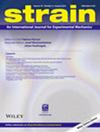Material characterization of curved shells under finite deformation using the virtual fields method
IF 2.4
3区 材料科学
Q2 MATERIALS SCIENCE, CHARACTERIZATION & TESTING
引用次数: 1
Abstract
Although full‐field measurement techniques have been well established, material characterization from these data remains challenging. Often, no closed‐form solution exists between measured quantities and sought material parameters. In this paper, a novel approach to determine the stiffness of thin curved membranes is proposed, based on the virtual fields method (VFM). Utilizing Kirchhoff‐Love shell theory, we show that the displacements can be decomposed into an in‐plane displacement and a rotation of the mid‐surface of the shell. Consequently, the strain tensor at the outer surface of the shell can then be decomposed into a membrane and a bending part. This allows for the VFM to be applied based only on data of the outer surface and on surfaces of arbitrary curvature. The method is first applied to simulated data. It is shown that the elastic modulus can be identified with less than 5% error if the thickness and Poisson ratio are known accurately. A 5% uncertainty in either the Poisson ratio or the thickness changes the identified value by 5%. Then, the method is applied on experimental data acquired on rubber samples having a dome‐like shape. Tensile tests are performed on the same samples, which permits to assess the linearized Young's modulus of this material for moderate strains (0–2.1%). Using regression analysis, a Young's modulus of 1.21 ± 0.08 MPa is found. Next, we performed pressurization tests on eight dome‐like shapes with pressures up to 4 kPa. The average Young's modulus obtained with the novel virtual fields method is 1.20 ± 0.13 MPa. The results are in good agreement with the ones from the tensile test. Future applications could benefit from this method to analyse more complex shapes, for example those found in biological structures like arteries or eardrums.用虚场法研究有限变形下弯曲壳的材料特性
尽管已经建立了完整的现场测量技术,但从这些数据中对材料进行表征仍然具有挑战性。通常,在测量的数量和寻求的材料参数之间不存在闭合形式的解决方案。本文在虚拟场法的基础上,提出了一种确定弯曲薄膜刚度的新方法。利用Kirchhoff‐Love壳层理论,我们表明位移可以分解为平面内位移和壳层中表面的旋转。因此,壳体外表面的应变张量可以分解为薄膜和弯曲部分。这允许仅基于外表面的数据和任意曲率的表面来应用VFM。该方法首先应用于模拟数据。结果表明,如果厚度和泊松比准确已知,则弹性模量的识别误差小于5%。泊松比或厚度中5%的不确定性会使识别值变化5%。然后,将该方法应用于在具有圆顶形状的橡胶样品上获得的实验数据。对相同的样品进行拉伸试验,从而可以评估该材料在中等应变(0-2.1%)下的线性杨氏模量。使用回归分析,发现杨氏模量为1.21±0.08MPa。接下来,我们对八个圆顶形状进行了加压测试,压力高达4 kPa。用新的虚拟场方法获得的平均杨氏模量为1.20±0.13MPa。结果与拉伸试验结果吻合较好。未来的应用可以受益于这种方法来分析更复杂的形状,例如在动脉或耳膜等生物结构中发现的形状。
本文章由计算机程序翻译,如有差异,请以英文原文为准。
求助全文
约1分钟内获得全文
求助全文
来源期刊

Strain
工程技术-材料科学:表征与测试
CiteScore
4.10
自引率
4.80%
发文量
27
期刊介绍:
Strain is an international journal that contains contributions from leading-edge research on the measurement of the mechanical behaviour of structures and systems. Strain only accepts contributions with sufficient novelty in the design, implementation, and/or validation of experimental methodologies to characterize materials, structures, and systems; i.e. contributions that are limited to the application of established methodologies are outside of the scope of the journal. The journal includes papers from all engineering disciplines that deal with material behaviour and degradation under load, structural design and measurement techniques. Although the thrust of the journal is experimental, numerical simulations and validation are included in the coverage.
Strain welcomes papers that deal with novel work in the following areas:
experimental techniques
non-destructive evaluation techniques
numerical analysis, simulation and validation
residual stress measurement techniques
design of composite structures and components
impact behaviour of materials and structures
signal and image processing
transducer and sensor design
structural health monitoring
biomechanics
extreme environment
micro- and nano-scale testing method.
 求助内容:
求助内容: 应助结果提醒方式:
应助结果提醒方式:


